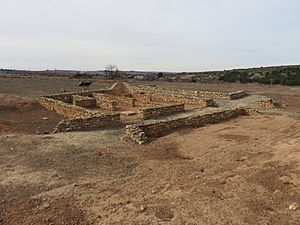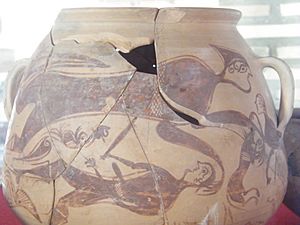Kelin facts for kids
Kelin was an ancient city built by the Iberians. It was located on a hill called Los Villares, near the modern town of Caudete de las Fuentes in Valencia, Spain. People lived in Kelin for a long time, starting around 700 BC (which is called the Proto-Iberian period). They stayed there until about 100 BC (the Late Iberian period).
The city of Kelin was surrounded by walls and covered an area of about 10 hectares (that's like 25 football fields!). People have known about this old city since the mid-1700s. But archaeologists, who study old things, first started digging there in 1956. They continued to find new things as recently as 2011.
Contents
What's in a Name? The Story of Kelin
The name 'Kelin' was found on ancient coins. These coins were made by the Iberians themselves. They had the name written in their special Iberian writing. Archaeologists found these coins both at the Kelin site and in other parts of the Iberian Peninsula.
These coins were called Iberian ases and semis. They were minted, or made, between the mid-2nd and early 1st centuries BC. This means they were used around 150 to 50 BC.
After the Romans arrived and started to influence the area (this is called Romanization), the main settlement moved. It moved to the banks of the Madre river. This happened from the 2nd century BC onwards. The new Roman name for this place was Caput Aquae, which means "water source." This Latin name eventually changed over time. First, it became Qabdaq in Muslim times, and then Cabdet in Valencian. Finally, it became the name of the modern town, Caudete de las Fuentes.
Was Kelin an Important Iberian Capital?
Many experts believe Kelin might have been the main city, or capital, of a large Iberian group. This group controlled much of the Utiel-Requena area. Kelin was quite big for an Iberian city. It covered 10 hectares and may have had around 3,800 people living there. This made it the largest known Iberian site in that region.
Throughout its long history, Kelin received many goods from other places. This suggests it was a major center for trading and distributing goods. More ancient writings have also been found at Kelin than at nearby sites. It also seems to be the only place in the area that made its own coins during the Roman Republican period.
All these clues together suggest that Kelin was a very important city. It was likely the most powerful place in its area. It might have even acted as a capital, controlling the lands around it.
Exploring the Ancient Homes of Kelin
When you visit the Kelin site today, you can see the remains of two different areas where houses once stood. These remains show how building styles changed from the 7th century BC to the 2nd century BC. The houses usually had long, rectangular rooms with not many walls inside.
The builders used stone for the foundations of the houses. The walls above the foundations were made from adobe bricks. Adobe is a type of brick made from mud and straw. At the edge of the site, you can still see a part of the ancient city wall. There's also a quarry nearby. This quarry might have been where they got the stone for the walls or for building the houses.
Archaeologists have found many types of pottery at Kelin. Some were made by hand. Others were made on a potter's wheel, which made them more perfectly round. They also found pieces of large storage jars called amphorae. These were used to carry liquids like wine or olive oil. Other finds include storage containers from Western Phoenicians and a special type of Iberian pottery called Red Slip ware.
Images for kids
See also
 In Spanish: Poblado ibérico amurallado Los Villares para niños
In Spanish: Poblado ibérico amurallado Los Villares para niños





